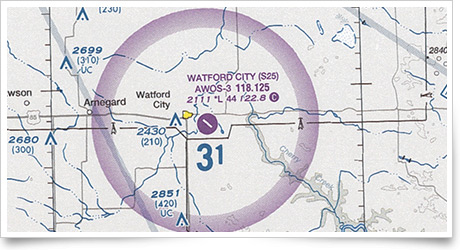Custom content for the Dec. 14, 2012, issue of 'AOPA ePilot' newsletter
| The following stories from the Dec. 14, 2012, edition of AOPA ePilot were provided to AOPA members who expressed an interest in the particular subject areas. Any AOPA member can receive information tailored to their areas of interest by updating their preferences online. |
training tipsKnown and unknown obstructions
Give careful study to the chart depictions of those obstructions. There may be more—or less—to them than what meets the eye on a chart. Or their descriptions may warn of incomplete or unverified information.
An aircraft flying between Watford City (N.D.) Municipal Airport and Sloulin International Airport to the northwest flies over an area of terrain approximately 2,000 feet mean sea level with charted maximum-elevation figures of 3,100 feet to 3,400 feet msl.
Several towers are charted obstructions west and northwest of Watford City; the highest one, south of Lake Sakakawea, rises to 2,720 feet msl. Symbols indicate that they are single (not group) obstructions that rise to less than 1,000 feet agl.
Note that one of those towers, identified as rising to 2,699 feet msl, or 310 feet agl (shown in parentheses) has the letters UC adjacent to the symbol. UC may indicate that the obstruction is under construction, but may also mean that the reported position and elevation are unverified, according to the legend of the Billings, Mont., sectional aeronautical chart.
Are there other sources of information about that obstruction?
A pilot conducting a recent preflight planning session for the Watford City-to-Sloulin flight would have found this notice to airmen: !GFK 12/015 S25 OBST TOWER 2698 (310 AGL) 9.5 WNW LGTS OTS (ASR 1058685) TIL 1212201806.
It would be worth knowing about those out-of-service lights that would lower the tower’s value as a visual checkpoint, and also for safety in reduced visibility.
As you gain cross-country flying experience, you will discover that not all obstructions are as easily spotted as their chart symbols would suggest—a good reason to build a generous safety margin into your selection of a VFR cruise altitude for flight through an obstacle-filled area.
Test your knowledge of obstruction avoidance with this Air Safety Institute Obstacle Clearance Safety Quiz. training productsSporty’s is offering a university-level complete instrument rating course that includes detailed video segments covering glass cockpits and analog gauges. The course is available on DVD or online.
The King Schools has a CD-ROM Sport Pilot Practical Test Course (Oral Exam & Flight Test) now available. You’ll learn on-screen exactly what the FAA wants you to demonstrate to earn your rating. Filling the role of the designated examiner is Rusty Sachs, former executive director of the National Association of Flight Instructors (NAFI), a master CFI, and an FAA-designated pilot examiner.
Note: Products listed have not been evaluated by ePilot editors unless otherwise noted. AOPA assumes no responsibility for products or services listed or for claims or actions by manufacturers or vendors. final examQuestion: What is the retesting procedure for the airline transport pilot (ATP) knowledge test? I know I don’t need an instructor endorsement to take the original test, but what if I score below 70 percent?
Answer: The answer is found in FAA Order 8080.6F. If you receive a grade lower than 70 percent and wish to retest, you must present the following to the testing center personnel: the failed Airman Test Report and a written endorsement from an authorized instructor certifying that additional instruction has been given and that the instructor finds you competent to pass the test. If you decide to retake the test in anticipation of a better score, you may retake the test 30 days after the date that your last test was accomplished. The FAA will not allow you to retake a passed test before the 30-day period has lapsed. Prior to retesting, you must give your current Airman Test Report to the test proctor. Be aware that your official score will be the last test taken.
Got a question for our technical services staff? Email [email protected] or call the Pilot Information Center, 800/872-2672. Don’t forget the online archive of “Final Exam” questions and answers, searchable by keyword or topic. |
 One of the most basic planning chores during a pilot’s preparation for a flight between two airports is to become familiar with terrain elevation on and around the route. Then you scan your navigation chart to locate individual obstructions along your course—both to ensure safe passage and possibly to use one or more of the objects as visual checkpoints.
One of the most basic planning chores during a pilot’s preparation for a flight between two airports is to become familiar with terrain elevation on and around the route. Then you scan your navigation chart to locate individual obstructions along your course—both to ensure safe passage and possibly to use one or more of the objects as visual checkpoints.

